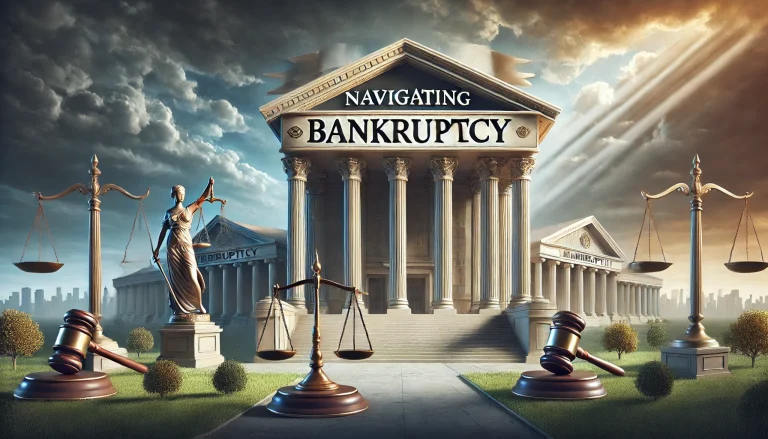Navigating bankruptcy can be challenging and intimidating, but it’s a process that can offer relief for those facing overwhelming debt. This guide will cover the basics of the bankruptcy process, the types of bankruptcy available, and the long-term effects that come with it. By understanding these elements, individuals and businesses can make informed decisions to improve their financial situation.
What is Bankruptcy?
Bankruptcy is a legal process aimed at helping individuals or businesses who cannot repay their debts. By navigating bankruptcy, debtors can either eliminate or restructure their debts under the supervision of a court. While bankruptcy may seem drastic, it provides an opportunity for a fresh financial start. This section will explore the basics and the reasons people and businesses consider bankruptcy as a financial solution.
Navigating Bankruptcy: The Basics of Filing
When it comes to navigating bankruptcy, the process begins with a series of steps to evaluate eligibility and determine the appropriate type of bankruptcy. Filing involves gathering financial documents, disclosing assets and liabilities, and listing income and expenses. The process requires full transparency, as the court will assess each filer’s financial situation. Most filers are also required to complete a credit counseling course, which helps them consider alternatives and understand the effects of bankruptcy.
Understanding the Types of Bankruptcy
Navigating bankruptcy involves choosing the right type of bankruptcy for your situation. Each type of bankruptcy offers different solutions depending on the type of debtor and the financial problems they face. The most common types for individuals are Chapter 7 and Chapter 13, while Chapter 11 is more common for businesses.
- Chapter 7: Often referred to as liquidation bankruptcy, Chapter 7 allows for the discharge of unsecured debts through the sale of non-exempt assets.
- Chapter 13: Known as reorganization bankruptcy, Chapter 13 allows individuals to create a repayment plan lasting three to five years.
- Chapter 11: This type is primarily for businesses seeking to reorganize debt and keep operations running.
Navigating Bankruptcy Through Chapter 7
Chapter 7 bankruptcy, commonly known as liquidation bankruptcy, is for individuals who lack the income to repay their debts. Navigating bankruptcy through Chapter 7 involves liquidating non-essential assets to repay creditors. Once assets are liquidated, remaining eligible debts are discharged, relieving the filer of their obligations. However, filers must meet a means test to qualify, which evaluates their income compared to the state median.
Navigating Bankruptcy Through Chapter 13
Chapter 13, or reorganization bankruptcy, is typically for individuals who have a steady income but need help managing their debt. Navigating bankruptcy through Chapter 13 allows debtors to create a manageable repayment plan, often reducing interest and total debt. This plan provides debtors with protection from creditors while they repay their debt over time. Chapter 13 is ideal for those who want to keep their assets, such as a home or car, and can manage monthly payments.
Bankruptcy for Businesses: Chapter 11 Explained
Businesses struggling with debt often turn to Chapter 11 to keep operations running while restructuring their debt. Navigating bankruptcy through Chapter 11 provides businesses with the ability to renegotiate terms with creditors, reduce liabilities, and sometimes secure new financing. Chapter 11 is complex, often involving court-approved reorganization plans. However, it allows businesses a chance to continue operating and return to profitability over time.
The Pros and Cons of Navigating Bankruptcy
Bankruptcy can offer significant relief, but it also comes with drawbacks. Understanding the pros and cons is essential when navigating bankruptcy:
- Pros: Debt relief, protection from creditors, and a chance to rebuild finances.
- Cons: Negative impact on credit, potential loss of assets, and long-lasting effects on creditworthiness.
Navigating bankruptcy carefully and understanding these trade-offs allows filers to make a more informed decision.
The Long-Term Effects of Bankruptcy on Credit
One of the most significant long-term effects of navigating bankruptcy is the impact on credit. Both Chapter 7 and Chapter 13 bankruptcies remain on credit reports for several years, affecting credit scores and future borrowing power. Chapter 7 remains for up to 10 years, while Chapter 13 remains for seven years. However, with responsible financial behavior, individuals can rebuild their credit over time.
Rebuilding After Bankruptcy: Tips for Financial Recovery
After navigating bankruptcy, individuals must focus on rebuilding their financial health. This process involves creating a budget, managing expenses, and avoiding new debt. By monitoring credit reports, paying bills on time, and using secured credit cards, individuals can gradually improve their credit scores. Recovery may take time, but with diligence, filers can regain financial stability.
Alternatives to Bankruptcy
Bankruptcy should be considered a last resort, and there are often alternative ways to manage debt. Navigating bankruptcy alternatives, such as debt consolidation, credit counseling, and debt settlement, may provide relief without the long-term effects of filing for bankruptcy.
- Debt Consolidation: Combining multiple debts into a single loan, often at a lower interest rate.
- Credit Counseling: Nonprofit agencies help individuals create debt management plans.
- Debt Settlement: Negotiating reduced debt balances with creditors.
Exploring these alternatives can often help individuals or businesses avoid the challenges associated with navigating bankruptcy.
Conclusion
Navigating bankruptcy can be a daunting journey, but understanding the process, types, and long-term effects can empower individuals and businesses to make sound financial decisions. Bankruptcy offers a fresh start for those facing unmanageable debt, though it does come with certain consequences. With time, effort, and responsible financial practices, recovery is possible. For anyone struggling with debt, considering all available options and seeking guidance can help achieve financial freedom and stability.

